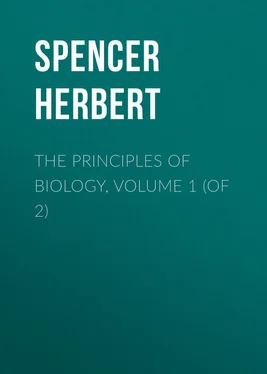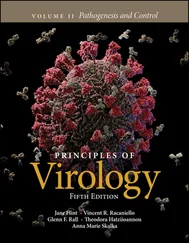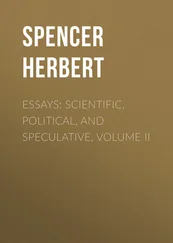Herbert Spencer - The Principles of Biology, Volume 1 (of 2)
Здесь есть возможность читать онлайн «Herbert Spencer - The Principles of Biology, Volume 1 (of 2)» — ознакомительный отрывок электронной книги совершенно бесплатно, а после прочтения отрывка купить полную версию. В некоторых случаях можно слушать аудио, скачать через торрент в формате fb2 и присутствует краткое содержание. Жанр: Философия, foreign_antique, foreign_prose, на английском языке. Описание произведения, (предисловие) а так же отзывы посетителей доступны на портале библиотеки ЛибКат.
- Название:The Principles of Biology, Volume 1 (of 2)
- Автор:
- Жанр:
- Год:неизвестен
- ISBN:нет данных
- Рейтинг книги:3 / 5. Голосов: 1
-
Избранное:Добавить в избранное
- Отзывы:
-
Ваша оценка:
- 60
- 1
- 2
- 3
- 4
- 5
The Principles of Biology, Volume 1 (of 2): краткое содержание, описание и аннотация
Предлагаем к чтению аннотацию, описание, краткое содержание или предисловие (зависит от того, что написал сам автор книги «The Principles of Biology, Volume 1 (of 2)»). Если вы не нашли необходимую информацию о книге — напишите в комментариях, мы постараемся отыскать её.
The Principles of Biology, Volume 1 (of 2) — читать онлайн ознакомительный отрывок
Ниже представлен текст книги, разбитый по страницам. Система сохранения места последней прочитанной страницы, позволяет с удобством читать онлайн бесплатно книгу «The Principles of Biology, Volume 1 (of 2)», без необходимости каждый раз заново искать на чём Вы остановились. Поставьте закладку, и сможете в любой момент перейти на страницу, на которой закончили чтение.
Интервал:
Закладка:
Whether a nerve is merely a conductor, which delivers at one of its extremities an impulse received at the other, or whether, as some now think, it is itself a generator of force which is initiated at one extremity and accumulates in its course to the other extremity, are questions which cannot yet be answered. All we know is that agencies capable of working molecular changes in nerves are capable of calling forth from them manifestations of activity. And our evidence that nerve-force is thus originated, consists not only of such facts as the above, but also of more conclusive facts established by direct experiments on nerves – experiments which show that nerve-force results when the cut end of a nerve is either mechanically irritated, or acted on by some chemical agent, or subject to the galvanic current – experiments which prove that nerve-force is generated by whatever disturbs the molecular equilibrium of nerve-substance.
§ 22. The most important of the re-actions called forth from organisms by surrounding actions, remains to be noticed. To the various forms of insensible motion thus caused, we have to add sensible motion. On the production of this mode of force more especially depends the possibility of all vital phenomena. It is, indeed, usual to regard the power of generating sensible motion as confined to one out of the two organic sub-kingdoms; or, at any rate, as possessed by but few members of the other. On looking closer into the matter, however, we see that plant-life as well as animal-life, is universally accompanied by certain manifestations of this power; and that plant-life could not otherwise continue.
Through the humblest, as well as through the highest, vegetal organisms, there are ever going on certain re-distributions of matter. In Protophytes the microscope shows us an internal transposition of parts, which, when not immediately visible, is proved to exist by the changes of arrangement that become manifest in the course of hours and days. In the individual cells of many higher plants, an active movement among the contained granules may be witnessed. And well-developed cryptogams, in common with all phanerogams, exhibit this genesis of mechanical motion still more conspicuously in the circulation of sap. It might, indeed, be concluded a priori , that through plants displaying much differentiation of parts, an internal movement must be going on; since, without it, the mutual dependence of organs having unlike functions would be impossible. Besides keeping up these motions of liquids internally, plants, especially of the lower orders, move their external parts in relation to each other, and also move about from place to place. There are countless such illustrations as the active locomotion of the zoospores of many Algæ , the rhythmical bendings of the Oscillatoræ , the rambling progression of the Diatomaceæ . In fact many of these smallest vegetals, and many of the larger ones in their early stages, display a mechanical activity not distinguishable from that of the simplest animals. Among well-organized plants, which are never locomotive in their adult states, we still not unfrequently meet with relative motions of parts. To such familiar cases as those of the Sensitive plant and the Venus' fly-trap, many others may be added. When its base is irritated the stamen of the Berberry flower leans over and touches the pistil. If the stamens of the wild Cistus be gently brushed with the finger, they spread themselves: bending away from the seed-vessel. And some of the orchid-flowers, as Mr. Darwin has shown, shoot out masses of pollen on to the entering bee, when its trunk is thrust down in search of honey.
Though the power of moving is not, as we see, a characteristic of animals alone, yet in them, considered as a class, it is manifested to an extent so marked as practically to become their most distinctive trait. For it is by their immensely greater ability to generate mechanical motion, that animals are enabled to perform those actions which constitute their visible lives; and it is by their immensely greater ability to generate mechanical motion, that the higher orders of animals are most obviously distinguished from the lower orders. Though, on remembering the seemingly active movements of infusoria, some will perhaps question this last-named contrast, yet, on comparing the quantities of matter propelled through given spaces in given times, they will see that the momentum evolved is far less in the Protozoa than in the Metazoa . These sensible motions of animals are effected in sundry ways. In the humblest forms, and even in some of the more developed forms which inhabit the water, locomotion results from the oscillations of whip-like appendages, single or double, or from the oscillations of cilia: the contractility resides in these waving hairs that grow from the surface. In many Cœlenterata certain elongations or tails of ectodermal or endodermal cells shorten when stimulated, and by these rudimentary contractile organs the movements are effected. In all the higher animals, however, and to a smaller degree in many of the lower, sensible motion is generated by a special tissue, under a special excitement. Though it is not strictly true that such animals show no sensible motions otherwise caused, since all of them have certain ciliated membranes, and since the circulation of liquids in them is partially due to osmotic and capillary actions; yet, generally speaking, we may say that their movements are effected solely by muscles which contract solely through the agency of nerves.
What special transformations of force generate these various mechanical changes, we do not, in most cases, know. Those re-distributions of liquid, with the alterations of form sometimes caused by them, that result from osmose, are not, indeed, incomprehensible. Certain motions of plants which, like those of the "animated oat," follow contact with water, are easily interpreted; as are also such other vegetal motions as those of the Touch-me-not, the Squirting Cucumber, and the Carpobolus . But we are ignorant of the mode in which molecular movement is transformed into the movement of masses, in animals. We cannot refer to known causes the rhythmical action of a Medusa's disc, or that slow decrease of bulk which spreads throughout the mass of an Alcyonium when one of its component individuals has been irritated. Nor are we any better able to say how the insensible motion transmitted through a nerve, gives rise to sensitive motion in a muscle. It is true that Science has given to Art several methods of changing insensible into sensible motion. By applying heat to water we vaporize it, and the movement of its expanding vapour we transfer to solid matter; but evidently the genesis of muscular movement is in no way analogous to this. The force evolved in a galvanic battery or by a dynamo, we communicate to a soft iron magnet through a wire coiled round it; and it would be possible, by placing near to each other several magnets thus excited, to obtain, through the attraction of each for its neighbours, an accumulated movement made up of their separate movements, and thus mechanically to imitate a muscular contraction. But from what we know of organic matter there is no reason to suppose that anything analogous to this takes place in it. We can, however, through one kind of molecular change, produce sensible changes of aggregation such as possibly might, when occurring in organic substance, cause sensible motion in it. I refer to change that is allotropic or isomeric. Sulphur, for example, assumes different crystalline and non-crystalline forms at different temperatures, and may be made to pass backwards and forwards from one form to another, by slight variations of temperature: undergoing each time an alteration of bulk. We know that this allotropism, or rather its analogue isomerism, prevails among colloids – inorganic and organic. We also know that some of these metamorphoses among colloids are accompanied by visible re-arrangements: instance hydrated silicic acid, which, after passing from its soluble state to the state of an insoluble jelly, begins, in a few days, to contract and to give out part of its contained water. Now considering that such isomeric changes of organic as well as inorganic colloids, are often rapidly produced by very slight causes – a trace of a neutral salt or a degree or two rise of temperature – it seems not impossible that some of the colloids constituting muscle may be thus changed by a nervous discharge: resuming their previous condition when the discharge ceases. And it is conceivable that by structural arrangements, minute sensible motions so caused may be accumulated into large sensible motions.
Читать дальшеИнтервал:
Закладка:
Похожие книги на «The Principles of Biology, Volume 1 (of 2)»
Представляем Вашему вниманию похожие книги на «The Principles of Biology, Volume 1 (of 2)» списком для выбора. Мы отобрали схожую по названию и смыслу литературу в надежде предоставить читателям больше вариантов отыскать новые, интересные, ещё непрочитанные произведения.
Обсуждение, отзывы о книге «The Principles of Biology, Volume 1 (of 2)» и просто собственные мнения читателей. Оставьте ваши комментарии, напишите, что Вы думаете о произведении, его смысле или главных героях. Укажите что конкретно понравилось, а что нет, и почему Вы так считаете.












